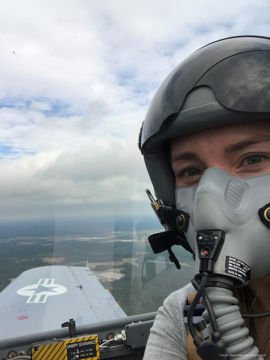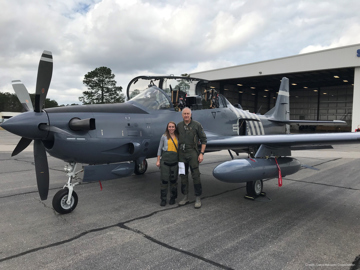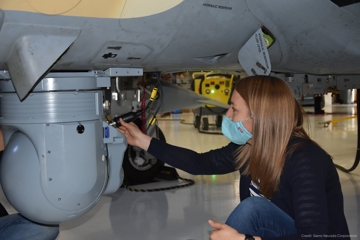Meet Amanda, a Project Engineering Manager for SNC’s A-29 Super Tucano Program
The A-29 program is one of SNC’s flagship programs. IAS won its first A-29 contract in 2009, and since then, we have helped coalition partner nations acquire the aircraft via Foreign Military Sales (FMS) alongside the US government.
we have helped coalition partner nations acquire the aircraft via Foreign Military Sales (FMS) alongside the US government.
The A-29 is excellent for operations in non-ideal environments like unpaved runways, high altitudes and hot climates. The A-29 is now known as the gold standard for light attack aircraft around the world.
Amanda M. is an A-29 Project Engineering Manager who is responsible for the technical solution for one of SNC’s A-29 FMS programs. She recently conducted test flights in Centennial for the certification of new capabilities unique to a FMS fleet before the aircraft ferried to Moody Air Force Base to support training with the customer.
We chatted with Amanda to find out what inspires her work and what advice she has to share with young engineers.
Amanda, share a little about your background and how you came to SNC.
I’m from the Kansas City area, and I went to school there – at the University of Kansas – Rock Chalk Jayhawk! I have a degree in Civil Engineering with an emphasis in Structures.
I started at SNC as an intern while taking graduate classes after working at L3 for a few years. After being on-boarded and experiencing what it’s like to be here, I came on full time and have been here ever since. That was nine years ago.
 What’s your favorite part of working at SNC?
What’s your favorite part of working at SNC?
I love that my job offers so many different opportunities. We get to see a lot of different types of integration and tests – and sometimes we get to fly!
Tell us a little about what you do? What exactly is a Project Engineering Manager?
My job [is multi-pronged]. I ensure that we execute the program in accordance with the requirements. I’m also the technical liaison between the Program Management team and the Engineering team. But most importantly, my job is to be a support for all the great Engineers that we have on this program – to make sure that they have everything that they need – that we remove as many barriers as we can, providing resources or training, or anything else they need to be able to do a good job. That’s what I’m here for; essentially I’m the “clean-up crew.”
So tell us what it was like to fly in the A-29. I’m sure there was a lot of preparation involved in preparing for this test flight!
preparing for this test flight!
We have been working on this engineering package for the last two years so it has been a lengthy process. We completed a ground test in November, which was successful, and then submitted all of the artifacts to the government to obtain a flight test MFR.
It culminates in a Command and Control flight test for the FLIR sensor; and laser firing testing in restricted airspace.
What advice would you share with young engineers looking to get into your field?
Advocate for yourself and go after the things that you want to do. There’s lots of opportunity if you’re willing to look for it!
---
Interested in joining the Sierra Nevada Corporation team? Apply today at sncorp.com/careers.